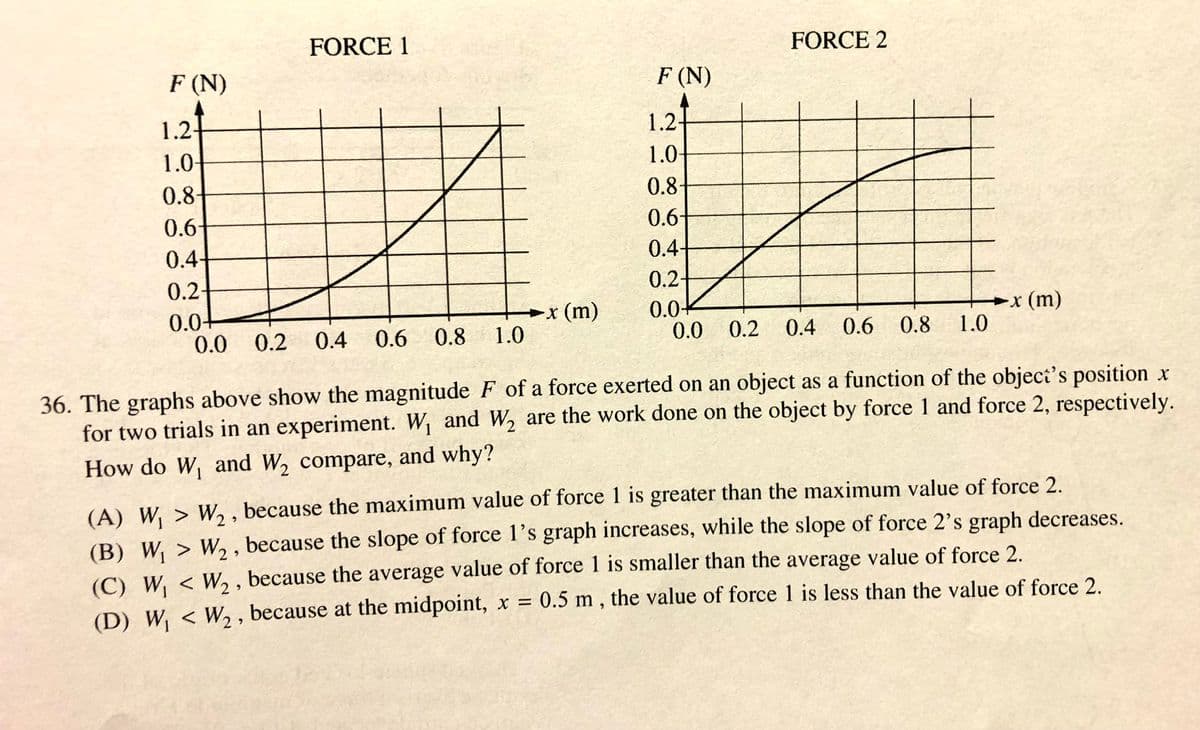FORCE 1 FORCE 2 F (N) F (N) 1.2 1.2- 1.0 1.0- 0.8 0.8- 0.6 0.4 0.2- 0.0- 0.0 0.6- 0.4- 0.2- ( (m) 1.0 0.0- 0.0 0.2 x (m) 1.0 0.2 0.4 0.6 0.8 0.4 0.6 0.8 36. The graphs above show the magnitude F of a force exerted on an object as a function of the object's position x for two trials in an experiment. W and W are the work done on the object by force 1 and force 2, respectively. How do W, and W2 compare, and why? (A) W, > W, , because the maximum value of force 1 is greater than the maximum value of force 2. (B) W, > W, , because the slope of force 1's graph increases, while the slope of force 2's graph decreases. (C) W, < W, , because the average value of force 1 is smaller than the average value of force 2. (D) W, < W, , because at the midpoint, x = 0.5 m , the value of force 1 is less than the value of force 2.
FORCE 1 FORCE 2 F (N) F (N) 1.2 1.2- 1.0 1.0- 0.8 0.8- 0.6 0.4 0.2- 0.0- 0.0 0.6- 0.4- 0.2- ( (m) 1.0 0.0- 0.0 0.2 x (m) 1.0 0.2 0.4 0.6 0.8 0.4 0.6 0.8 36. The graphs above show the magnitude F of a force exerted on an object as a function of the object's position x for two trials in an experiment. W and W are the work done on the object by force 1 and force 2, respectively. How do W, and W2 compare, and why? (A) W, > W, , because the maximum value of force 1 is greater than the maximum value of force 2. (B) W, > W, , because the slope of force 1's graph increases, while the slope of force 2's graph decreases. (C) W, < W, , because the average value of force 1 is smaller than the average value of force 2. (D) W, < W, , because at the midpoint, x = 0.5 m , the value of force 1 is less than the value of force 2.
Physics for Scientists and Engineers with Modern Physics
10th Edition
ISBN:9781337553292
Author:Raymond A. Serway, John W. Jewett
Publisher:Raymond A. Serway, John W. Jewett
Chapter14: Fluid Mechanics
Section: Chapter Questions
Problem 50CP
Related questions
Topic Video
Question
#36 AP Physics 1

Transcribed Image Text:FORCE 1
FORCE 2
F (N)
F (N)
1.2-
1.2-
1.0-
1.0
0.8-
0.8-
0.6
0.4-
0.2-
0.0+
0.0 0.2 0.4
0.6
0.4+
0.2-
0.0+
0.0 0.2 0.4
x (m)
►x (m)
1.0
0.6 0.8
1.0
0.6 0.8
36. The graphs above show the magnitude F of a force exerted on an object as a function of the object's position x
for two trials in an experiment. W and W, are the work done on the object by force 1 and force 2, respectively.
How do W, and W, compare, and why?
(A) W, > W, , because the maximum value of force 1 is greater than the maximum value of force 2.
(B) W, > W, , because the slope of force 1's graph increases, while the slope of force 2's graph decreases.
(C) W, < W, , because the average value of force 1 is smaller than the average value of force 2.
(D) W, < W, , because at the midpoint, x = 0.5 m , the value of force 1 is less than the value of force 2.
Expert Solution
This question has been solved!
Explore an expertly crafted, step-by-step solution for a thorough understanding of key concepts.
This is a popular solution!
Trending now
This is a popular solution!
Step by step
Solved in 2 steps

Knowledge Booster
Learn more about
Need a deep-dive on the concept behind this application? Look no further. Learn more about this topic, physics and related others by exploring similar questions and additional content below.Recommended textbooks for you

Physics for Scientists and Engineers with Modern …
Physics
ISBN:
9781337553292
Author:
Raymond A. Serway, John W. Jewett
Publisher:
Cengage Learning

Principles of Physics: A Calculus-Based Text
Physics
ISBN:
9781133104261
Author:
Raymond A. Serway, John W. Jewett
Publisher:
Cengage Learning

Physics for Scientists and Engineers
Physics
ISBN:
9781337553278
Author:
Raymond A. Serway, John W. Jewett
Publisher:
Cengage Learning

Physics for Scientists and Engineers with Modern …
Physics
ISBN:
9781337553292
Author:
Raymond A. Serway, John W. Jewett
Publisher:
Cengage Learning

Principles of Physics: A Calculus-Based Text
Physics
ISBN:
9781133104261
Author:
Raymond A. Serway, John W. Jewett
Publisher:
Cengage Learning

Physics for Scientists and Engineers
Physics
ISBN:
9781337553278
Author:
Raymond A. Serway, John W. Jewett
Publisher:
Cengage Learning

Physics for Scientists and Engineers, Technology …
Physics
ISBN:
9781305116399
Author:
Raymond A. Serway, John W. Jewett
Publisher:
Cengage Learning

College Physics
Physics
ISBN:
9781305952300
Author:
Raymond A. Serway, Chris Vuille
Publisher:
Cengage Learning

College Physics
Physics
ISBN:
9781285737027
Author:
Raymond A. Serway, Chris Vuille
Publisher:
Cengage Learning